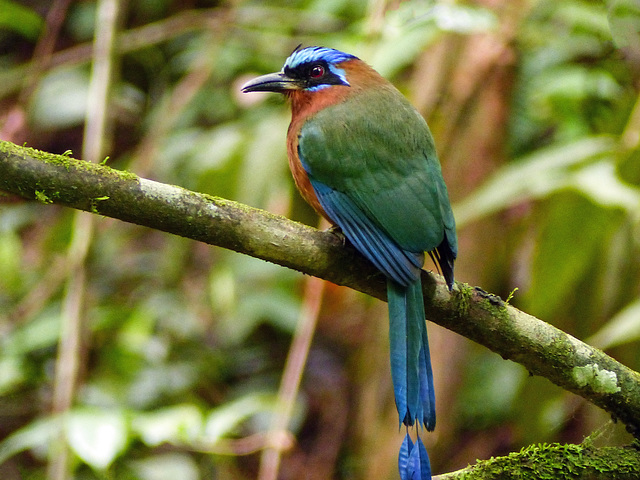Dog at Bloody Bay Recreation Centre, Tobago, Day 2
Autograph Tree / Clusia rosea, Main Ridge Forestry…
Purple Honeycreeper / Cyanerpes caeruleus, Asa Wri…
Trapdoor spider's closed burrow, Day 2
Trinidad Motmot with small snake
Plants at Bloody Bay Recreation Centre, Tobago, Da…
Trinidad Motmots, Tobago, Day 2
Sisters Rocks from Bloody Bay Recreation Centre, T…
Road near Bloody Bay Recreation Centre, Tobago, Da…
Trinidad Motmot, Main Ridge Forest Reserve, Tobago
Crested Oropendola (bird) nests, Main Ridge Forest…
Trinidad Motmot, Main Ridge Forest Reserve, Tobago
Tetrio Sphinx Moth caterpillar / Pseudosphinx tetr…
Caterpillar of Tetrio Sphinx Moth / Pseudosphinx t…
Tetrio Sphinx Moth caterpillar / Pseudosphinx tetr…
Hummingbird, Tobago
Hummingbird silhouette, Tobago
Looking from mainland Tobago to Little Tobago isla…
Diving boat, Blue Waters Inn, Tobago
Masked Cardinal / Paroaria nigrogenis, Trinidad, D…
Craft stand, Speyside, Tobago, Day 2
Boat trip to Little Tobago, Day 3
Frank's glass-bottomed boat, Tobago, Day 3
Main Ridge Forest Reserve, Tobago, Day 2
Bamboo, Main Ridge Forest Reserve, Tobago, Day 2
Autograph tree fruit, Gilpin Trace trail, Tobago,…
Insect galls on leaf, Main Ridge Forest Reserve, T…
Autograph tree fruit, Gilpin Trace trail, Tobago,…
Rain forest plants, Main Ridge Forest Reserve, Day…
Yellow-legged Thrush, Main Ridge Forestry Reserve,…
Stripe-breasted spinetail, Day 2
Gilpin Trace trail, Tobago, Day 2
Fungi, Main Ridge Forest Reserve trip, Day 2
Rain forest, Tobago, Day 2
Fungi, Main Ridge Forest Reserve, Day 2
Rain forest, Tobago Day 2
Plants of the rain forest, Tobago, Day 2
Humminbird nest, Tobago, Day 2
Dog at Bloody Bay Recreation Centre, Tobago, Day 2
Rufous-tailed Jacamar, Tobago, Day 2
Leafcutter Ants, Tobago, Day 2
Oropendola (bird) nests, Tobago, Day 2
Tropical plant, Tobago, Day 2
Oropendola (bird) nests, Day 2
Tropical butterfly, Tobago, Day 2
Location
See also...
Authorizations, license
-
Visible by: Everyone -
All rights reserved
-
128 visits
Trinidad Motmot, Tobago, Day 2


Early hours of the morning, on 4 April 2017, and I have just posted a whole pile of photos so that I can put them into my Trinidad & Tobago albums. I think I have pretty well finished Day 2 of our trip, apart from a handful of remaining images. There are several photos that are just about as bad as they could possibly be - posting them just for the record of what birds I saw. Will post two more when I have had some sleep, and they will be my main photos for today. No need to comment on the few dozen shots I've just added. I don't know how other people edit and upload all their holiday photos in such a short time - it's taking me forever : ) And now I must get to bed - it's 2:30 am!
"The most striking physical characteristic of Blue-crowned Motmots is their spatulate shaped, racqueted tail, which is formed by the loss of barbs on the two long, upper central tail feathers. The center retrices after molt are feathered throughout the length, only becoming spatulate after the natural loss of the barbs. At one time it was thought that the racqueted tail feathers were a result of the birds themselves removing the feathers, but it has been since found that the barbs are loosely attached at that region of the retrix and detach from the feather shaft on their own. Members of the genus Momotus are the only representatives of the family Momotidae that possess 12 retrices, all other members of the family possess 10. The center retrices in males tend to be slightly longer than those in the females." From link below.
www.coraciiformestag.com/Motmot/momotus/momotus.html
"The most striking physical characteristic of Blue-crowned Motmots is their spatulate shaped, racqueted tail, which is formed by the loss of barbs on the two long, upper central tail feathers. The center retrices after molt are feathered throughout the length, only becoming spatulate after the natural loss of the barbs. At one time it was thought that the racqueted tail feathers were a result of the birds themselves removing the feathers, but it has been since found that the barbs are loosely attached at that region of the retrix and detach from the feather shaft on their own. Members of the genus Momotus are the only representatives of the family Momotidae that possess 12 retrices, all other members of the family possess 10. The center retrices in males tend to be slightly longer than those in the females." From link below.
www.coraciiformestag.com/Motmot/momotus/momotus.html
- Keyboard shortcuts:
Jump to top
RSS feed- Latest comments - Subscribe to the comment feeds of this photo
- ipernity © 2007-2024
- Help & Contact
|
Club news
|
About ipernity
|
History |
ipernity Club & Prices |
Guide of good conduct
Donate | Group guidelines | Privacy policy | Terms of use | Statutes | In memoria -
Facebook
Twitter

Sign-in to write a comment.